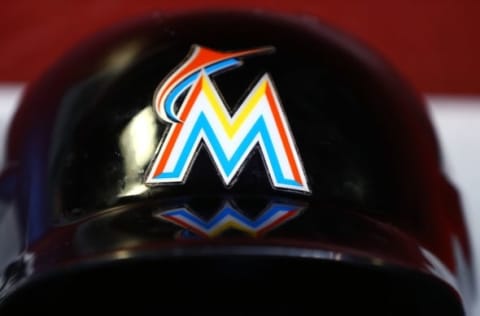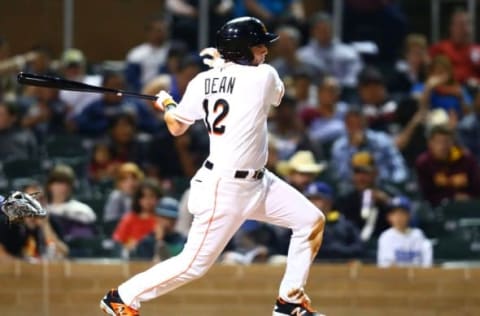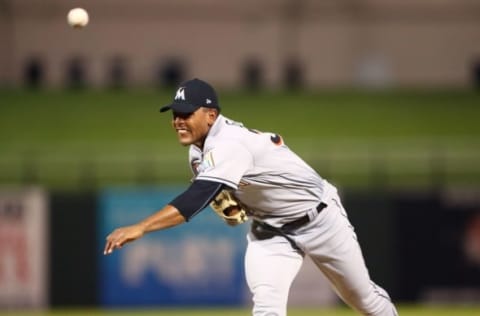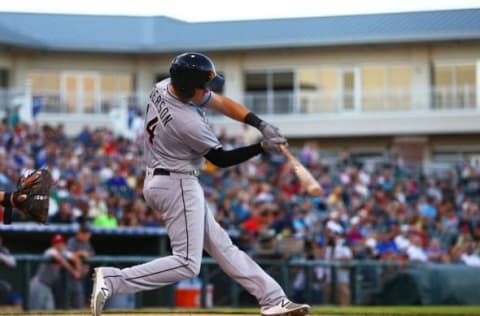Miami Marlins Top Ten Prospects For 2017


The Miami Marlins made a Wild Card push in 2016. Do they have the pieces in the minor leagues to help push the team farther in 2017?
An Introduction
Our minor league top 10 series is coordinated by Benjamin Chase, one of our contributors at Call To The Pen.
He has poured over thousands of minor league games over the course of the year via milb.tv along with speaking with a number of team and independent scouts. These lists are based out of those conversations.
Each system will have prospects from 10 to 1, and then finish with one newcomer to the system that is worth keeping an eye on that is not in the top 10 at this time.
Conversations are certainly encouraged in the comments section on each system as we go along!
Marlins System Review
The Miami Marlins should be sure to send the Angels a fruit basket this holiday season. Without the Angels system, right now, the Marlins would have a very strong argument for the worst overall system in the entire game. Instead, they’re in a group of 3-4 teams that are in the first tier up from the Angels, which isn’t exactly much to brag about.
The Marlins really can’t point to one reason for their system being in dire straits. In their effort to get pieces needed for their 2016 Wild Card run,
Next: #10
10. Isael Soto, OF
Birthdate: 11/2/96 (20 years old)
Level(s) Played in 2016: low A
Stats in 2016: .247/.320/.399, 9 HR, 3 SB
Signed out of the Dominican Republic in 2013, Soto is a guy that the Marlins have been holding back from trade talks whenever his name comes up, so there’s a big love for the player within the organization.
It’s fairly easy to see why when you watch him in batting practice. The swing has tremendous pop, with the ball absolutely exploding off of his bat in batting practice. His biggest issue is getting that same result in games.
Soto lost a year of development in 2015 to a torn meniscus, and he’s still bouncing back from that
Soto is a true right field profile outfielder with a plus arm and above-average fielding ability in the corner. His bat has the profile of a right fielder as well with plus-plus raw power, but exhibited fringe-plus power thus far in his career.
Soto lost a year of development in 2015 to a torn meniscus, and he’s still bouncing back from that. If you look at his 2016 as his second full season of development instead of his third, he’s really on a very solid track to becoming a power hitter.
His big step in 2017 will be in his pitch recognition to allow him to get to his power more frequently, likely doing so in the Florida State League.
Next: #9
9. Dillon Peters, LHP
Birthdate: 8/31/92 (24 years old)
Level(s) Played in 2016: high A, AA
Stats in 2016: 128 2/3 IP, 2.38 ERA, 1.08 WHIP, 3.85 BB%, 20.23 K%
The Marlins lucked into Peters in the 2014 draft in the 10th round when he suffered an elbow injury that required Tommy John surgery in May of his draft year, dropping him from a likely pick in the first three rounds.
Peters is a small guy, and that is the report that keeps being sent my way when I ask about him. It’s one of those things for me that will have to be gut, because when I watch Peters, I absolutely see a guy who can be a big league starter, even if he is only 5’9.
the most consistent pitch Peters throws is a curve with tremendously tight spin
The concern with Peters lies in a few things – his injury history with the TJS, his size, and the fact that his best pitch is a breaking pitch.
Right now, the most consistent pitch Peters throws is a curve with tremendously tight spin. He gets consistent location on the pitch and seems to be able to spot it nearly anywhere below the mid-thigh on the hitter, to both sides of the plate.
His fastball to me is a bit underrated. While it’s not premium in velocity at 89-92, touching 94, he gets excellent sink on the pitch, and he also works in different grips to get cut action on the pitch.
Add in a circle change that gets plenty of weak contact in its late movement, and you have a very solid mid-rotation starter, size be darned.
Peters losing the year to Tommy John has led to him being an “older” prospect at 24 leading into 2017, but he’ll likely start at AA/AAA to open the season, and it wouldn’t surprise me at all if he’s making overtures toward the rotation by the end of the season.
Next: #8

8. Austin Dean, OF
Birthdate: 10/14/93 (23 years old)
Level(s) Played in 2016: AA
Stats in 2016: .238/.307/.375, 11 HR, 1 SB
Dean is a guy that should really get your attention, but yet he’s never really put together his balanced skill set in a way that makes scouts fall in love with his chances going forward.
Dean doesn’t really have one standout tool, with a solid average ability to make contact and barrel up balls for decent power. He’s also a good enough runner to work into center field, but probably profiles best in left, where his average arm would play better.
(Dean)’s held all these average tools since being drafted in 2012 in the 4th round out of high school
Yet, he’s held all these average tools since being drafted in 2012 in the 4th round out of high school. He moved out of the infield to the outfield as a pro, but other than that, the profile is not much changed over that time, which is not exactly a good thing after what should be 4 years of development in the system.
Dean does have the physicality to develop more power and has flashed gap power at times, including 23 homers and 5 triples this year to go along with his 11 home runs, but his struggle to recognize premium breaking stuff led to a high strikeout rate on the year.
Next: #7
7. Stone Garrett, OF
Birthdate: 11/22/95 (21 years old)
Level(s) Played in 2016: rookie, low A
Stats in 2016: .211/.268/.363, 6 HR, 2 SB
An impressive physical athlete on the field, Garrett is still waiting for his baseball skills to catch up with that athleticism.
Garrett had a big season in 2015 in short-season ball, but injured his wrist before he could get going in 2016, and he never got his season off the ground. Worst of all, he seemed to regress in some areas that he’d made significant progress in 2015.
Garrett had a big season in 2015 in short-season ball, but injured his wrist before he could get going in 2016
Garrett is a guy who could definitely profile in center field with his fringe-plus speed, though he would need to work on his reads on balls off the bat. He also has an average-ish arm, which doesn’t excite many evaluators about keeping him in center. Moving him to left could allow him to play an elite level of left field defense, however, which could up his value.
The bat is going to determine how far Garrett goes. While he has a very good physicality to have blistering offensive stats, he’s struggled with a poor mechanical swing that the Marlins have been working to clean up since he came into the organization.
Coming back from the wrist injury, Garrett slipped back into old habits with his swing, and it showed in his exorbitant strikeout rate.
He’ll likely return back to low-A this season and hope for a healthy year where he can move quickly as he’s already 21 at this point.
Next: #6
6. Thomas Jones, OF
Birthdate: 12/9/97 (18 years old)
Level(s) Played in 2016: rookie
Stats in 2016: .234/.380/.313, 6 SB
One of the most impressive athletes in the draft this past June, Jones was a legitimate big-time college recruit who had signed with an SEC school to play both football and baseball, which led to signability concerns, dropping him into the Marlins’ lap in the 3rd round.
Right now, the carrying tool for Jones will be his plus-plus speed. He has an above-average arm in the outfield and excellent instincts to go along with the speed, which should allow him to profile as a front-line defender in center field.
(Jones has) got plus raw power that is impressive to watch in batting practice
Offensively, his speed had carried his production his first three years of high school before a hamstring injury at the outset of his senior year slowed down those legs. He was able to display the excellent pitch recognition and raw power he had in his 6’4, 200 pound frame instead.
He’s got plus raw power that is impressive to watch in batting practice, but so far, he’s not translated that into games. What was impressive in his pro debut was that he walked almost 14% of the time, which is a huge plus for a guy who was deemed as a fairly raw athlete.
He likely will be at the short-season New York-Penn League this season, but the Marlins could push him forward to full-season ball, though I think that’d be a bad choice at this time.
Next: #5

5. Jarlin Garcia, LHP
Birthdate: 1/18/93 (23 years old)
Level(s) Played in 2016: rookie, high A, AA
Stats in 2016: 50 2/3 IP, 3.73 ERA, 1.09 WHIP, 5.77 BB%, 18.27 K%
Signed in 2010 out of the Dominican, Garcia was just a big arm with projection until he broke out in 2014. He then was in the midst of another step forward this season before a triceps injury derailed his season.
Garcia has a smooth delivery from the left side, and he really has a nice feel for all four of his pitches, leading to very solid control. It’s really control more than command right now, as he does miss his spots still at time, but he tends to miss in the zone.
Garcia has a smooth delivery from the left side, and he really has a nice feel for all four of his pitches
Garcia isn’t huge, but he does do very well getting plane low in the zone on his fastball with his fastball that sits low-90s. He also has seen his curve really step forward as an excellent ground ball generating pitch.
His slider and change are both average pitches that play up when he is working better with his command, but his change has a chance to be a plus pitch as it has really added movement to go with solid arm deception.
Garcia will look to re-capture the form he was showing early in the year, which would be a #4 type of starter that generates a ton of grounders and eats up innings before he was hurt, likely starting out at AA and working his way back up the system again.
Next: #4
4. Luis Castillo, RHP
Birthdate: 12/12/92 (23 years old)
Level(s) Played in 2016: high A, AA
Stats in 2016: 131 2/3 IP, 2.26 ERA, 1.00 WHIP, 4.81 BB%, 19.81 K%
Castillo was acquired from the Giants by the Marlins in the Casey McGehee deal, and he was nearly shipped out in the Colin Rea fiasco with the Padres this summer, so he’s been bounced around a bit.
Castillo’s stuff, while raw, isn’t the type that you’d think to bounce around the way it has. He has a fastball that clears triple digits with ease and sits in the 94-96 range consistently.
Castillo’s stuff, while raw, isn’t the type that you’d think to bounce around the way it has
He throws his slider like a power sinker, getting heavy late action on the pitch with a higher velocity than your average slider when he’s got a good feel for it. When he’s working both, he’s got a legitimate plus fastball and slider.
His change has been a work in progress, but he made big strides with at least sequencing the pitch this season, using it well against same-handed and opposite-handed hitters.
He does have much more control than command right now, but his stuff all works low in the zone, and creates a lot of weak contact, generally missing the barrel and allowing for him to have tremendous success with lower strikeout rates.
He profiles as a mid-rotation starter that should likely start 2017 in the upper minors, whether AA or AAA, and could see time in Miami this season.
Next: #3
3. Tyler Kolek, RHP
Birthdate: 12/15/95 (20 years old)
Level(s) Played in 2016: none
Stats in 2016: none
A premier example of the unadulterated search for velocity in the major leagues, Kolek was the #2 overall selection in 2014. He was pretty much a guarantee to the Marlins at #2 the entire draft process, so it was no surprise when they made their selection.
It’s also been no surprise that a guy who can throw 100 without a lot more to add to his repertoire has struggled as a pro and is not recovering from Tommy John surgery.
More from Miami Marlins
- The Miami Marlins actually do have a Jazz Chisholm problem
- Square one at catcher? Miami Marlins sign former backstop Jorge Alfaro
- Miami Marlins remake their infield at MLB trade deadline for playoff push
- Miami Marlins make late night splash with David Robertson trade
- MLB trade deadline: Nationals and Mets for sale, plus wish lists for Phillies, Braves, Marlins
Kolek had taken some steps back in the views of those around the industry due to his performance in 2015 regardless of his injury.
While he can run his fastball to upper-90s consistently and touch 100+, he sits more in the 92-95 range with heavy sinking action on the pitch. He generated a lot of ground ball outs in his 2015 season with his fastball due to that action.
His secondary offerings are so far behind, however, that hitters are able to simply sit on the fastball. His slider flashed some positive strides, but overall is still a below-average pitch, and his change is even farther behind.
He’ll return from surgery in early- to mid-2017, but he’ll have a year of getting his velocity back before he can start really working on command that he never really had in the first place along with developing secondary stuff he had.
That will put his time line in the 2020 late-season call up range with his first real chance to compete for a big league job, if all goes well, at 2021, when he’ll already be 25 entering the season.
It wouldn’t surprise me if the Marlins scrap the change and develop Kolek as a power closer, but that would hurt to do so soon after taking him ahead of such players as Carlos Rodon, Kyle Schwarber, Trea Turner, Aaron Nola, and many more that have established themselves already either in the high minors or in the major leagues from the 2014 draft class.
Next: #2

2. Brian Anderson, 3B
Birthdate: 5/19/93 (23 years old)
Level(s) Played in 2016: high A, AA
Stats in 2016: .265/.348/.389, 11 HR, 3 SB
Coming out of college, Anderson was already highly-regarded defender, with some feeling he could play either position on the left side of the infield his glove work was so strong.
The bat was more raw, but there was plenty to dream on. This season started to see some of that work pay off. He has solid raw power in batting practice, but he struggled to translate that into real game power until this season, when he put up 21 doubles, 3 triples, and 11 home runs in 483 at bats in two pitching-strong leagues.
More from Call to the Pen
- Philadelphia Phillies, ready for a stretch run, bomb St. Louis Cardinals
- Philadelphia Phillies: The 4 players on the franchise’s Mount Rushmore
- Boston Red Sox fans should be upset over Mookie Betts’ comment
- Analyzing the Boston Red Sox trade for Dave Henderson and Spike Owen
- 2023 MLB postseason likely to have a strange look without Yankees, Red Sox, Cardinals
Anderson then went to the Arizona Fall League, and he has received big time praise at the AFL, which led me to bump him up this high. Anderson’s defense is already grading as a major league above-average defender at third, and the bat is said to be playable at this point at third, with more there that could still develop.
Late developing guys like Anderson often take baseball by surprise and have a short, bright time in the big leagues, akin to someone like Bill Mueller, who was solid enough with the glove to stick after breaking in late until he had three big offensive years in his early 30s.
Anderson isn’t the contact guy that Mueller is, but figuring a similar run for a guy who could provide power along with solid defense until he has that mid-career boom would be a not-surprising career arc.
Next: #1
1. Braxton Garrett, LHP
Birthdate: 8/5/97 (19 years old)
Level(s) Played in 2016: none
Stats in 2016: none
Garrett just seemed to climb higher and higher as the draft came closer this year. When I first started getting reports on Garrett, he was considered the third-best lefty in the high school class behind Jason Groome and Joey Wentz.
Garrett ended up the first high school left-hander selected in the draft, six picks ahead of Groome and over 30 selections ahead of Wentz. His helium was peaked when he seemed to strike out every hitter at the National High School Invitational.
That left an impression with scouts, and while Garrett wasn’t really considered above the Marlins selection, he was highly connected to the Marlins, and they got their man.
Garrett’s best pitch is his curve that has excellent depth from its 12-6 break. The pitch has tremendous spin that allows it to miss bats and create weak contact both.
He works that with a fastball that runs into the mid-90s and a change that he has tremendous feel for, especially for a high school arm.
Garrett is likely the only top 100 guy in the entire system. He will probably be at extended spring, but the Marlins could push him to a full-season team right away.
Next: Newcomer To Watch
Newcomer To Keep An Eye On: Sean Reynolds, OF
Birthdate: 4/19/98 (18 years old)
Level(s) Played in 2016: rookie
Stats in 2016: .155/.262/.196, 3 SB
You’re probably wondering why on earth I would put a guy who had a .458 OPS as my “player to watch” that was drafted or signed by the Marlins this year and not on the top 10. If so, you need to take a look at the young man, and then realize that he’ll still be 18 on opening day in 2017.
Reynolds is a physical beast at 6’7 and 205 pounds listed, though with his musculature, it would not surprise me if he was even as much as 220 without it being bad weight at all.
He didn’t hit a single home run in his 42 games in the GCL, but the raw power he displayed when everything comes together is absolutely nuts, easily a plus-plus raw power tool in practice.
Reynolds has some length and hitch in his swing mechanics that will need to be cleaned up, so he will not be a guy who will likely move quickly early, but once it does come together, he could jump forward fast.
I heard three different scouts throw out Aaron Judge comps on Reynolds, which would be an impressive comparison, but that’s also a sign of the risk/reward of a guy this size as Judge has taken time to develop his swing with his long levers.
Reynolds is a tremendous athlete as well, with a legit above-average run tool, good instincts in right field, and an arm that could rate as plus-plus as he works on accuracy from the outfield. He also was a pitcher capable of throwing into the mid- to upper-90s in high school, so if all else fails, that would be a fallback plan for the Marlins.
Next: Dodgers Top 10 Prospects
Agree? Disagree? Someone you have a question about from the system? Leave a comment down below!